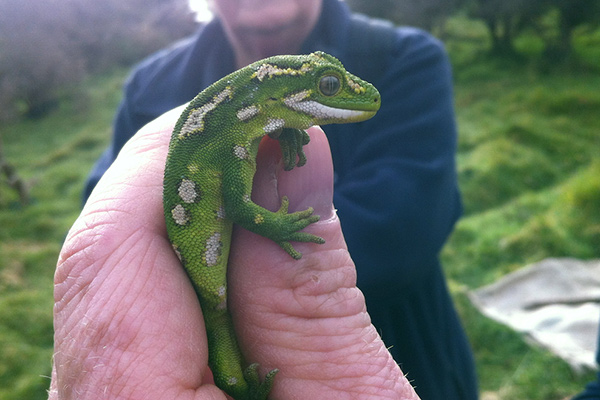Gecko geeks and preserving the peninsula
Native lizards cooler than birds, and don't eat your wipers
Carey Knox, a herpetologist for EcoGecko Consultants, says the markings along their backs are like fingerprints, making each gecko unique. Knox works with the Department of Conservation (DOC) and Save the Otago Peninsula (STOP) researching the geckos and revitalising the natural landscape.
There are over 100 species of lizard in New Zealand; 85 per cent are threatened or endangered. The jewelled gecko found in Otago and Canterbury varies in colour and pattern, but along the peninsula they are found in shades of lucid green and patterned with yellow, brown or white patches or stripes.
With a price tag in the thousands on the European black market, the preservation team are hesitant to welcome newcomers to the area. Lala Frazer of STOP is hopeful that a recent change to the Convention on International Trade in Endangered Species of Wild Fauna and Flora (CITES) will repel prospective poachers. Raising native green gecko species from Appendix III to II allows poachers to be eligible for prosecution even once they have left New Zealand. Further, a Members Bill introduced by National MP Jacqui Dean in 2013 entitled the Conservation (Natural Heritage Protection) Bill has increased penalties designed to protect wildlife.
Knox’s group Gecko Ecology and Conservation Otago (GECO) has become a way for enthusiastic science students to get up-close and personal with the peninsula. Frazer could barely contain her pride at having a group of enthusiastic youths continuing STOP’s work.
The struggle for Knox, STOP, and the peninsula is funding. While donors sponsor many of New Zealand’s native bird species, most lizard species live under the radar. Conservation efforts are at the mercy of DOC’s tightening budget, an issue that Green Party MP Eugenie Sage speaks out against. “[DOC] is investing more in community partnerships, but for these to work, there needs to be more technical support. Funding cuts are stretching the resources,” she says.
Until the funding can be increased, Knox’s next gecko mission is in the Catlins, where he has the chance to scope out the nationally endangered Southern Forest Gecko. Due to the species being hard to spot, Knox is testing new methods of detection, including an innovative foam cover attached to trees, and hopes to discover new populations.
The world of lizard research and conservation is remarkably underground given the number of native species New Zealand has at its disposal. Despite the potential stumbling blocks, there will continue to be a team of dedicated gecko enthusiasts committed to the little-known world of the Jewelled Gecko. They welcome fellow lizard lovers – if you can find them, that is.



